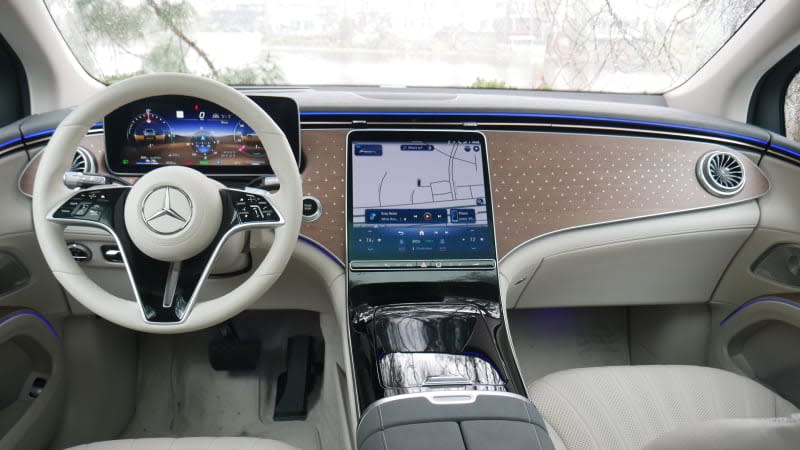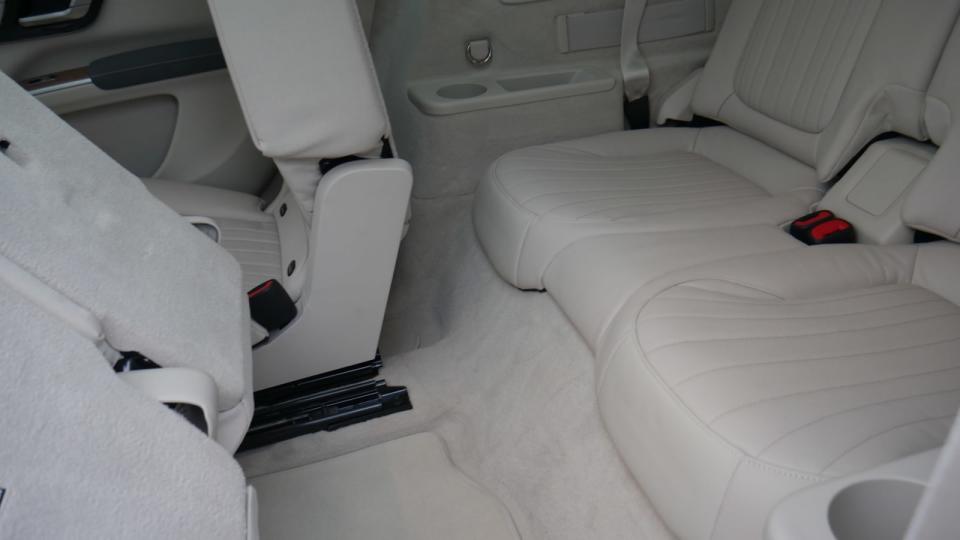2023 Mercedes-Benz EQS SUV Review: The most luxurious 3-row EV

Pros: Super-luxurious interior; the most cutting-edge tech you can get; plush ride; fast charging and solid range
Cons: Tiny cargo space behind tiny third-row seat; wonky regenerative brakes; questionable value; sleepy exterior design
The 2023 Mercedes-Benz EQS SUV brings a flagship, full-size electric vehicle into the Mercedes fold. It’s a big, three-row seven-seater, making it most comparable to the gasoline-powered GLS-Class. One glance at the design makes it clear you’re looking at something very different from Mercedes, though, as this SUV adopts the company’s smooth EQ family design. There are no sharp edges or chunky, rugged touches to be found, which is all in the name of reducing drag and increasing efficiency (plus clearly differentiating itself from its gas-powered family members).
Mercedes builds the EQS SUV on the same EV-specific platform as the EQS sedan, so it’s rocking the latest and best EV charging and motor tech the company has to offer. A maximum DC fast charging speed of 200 kilowatts means road trip fill-ups will be speedy. Tech abounds everywhere with top-notch driver assistance features standard and the available Hyperscreen infotainment system (though we prefer the base system). The base 450+ and 450 4Matic powertrains comparatively a little slow by luxury EV standards, but the 580 4Matic fixes that — you’re just going to pay a big premium for the better performance. The value proposition is where the EQS SUV’s biggest hang-up resides. It may have all the features and luxury you desire, but it’s pricey compared to the competition and third-row space is limited. The more spacious Rivian R1S is going to come in way cheaper, and if you don’t really need that third row, the BMW iX is a relative bargain. A Tesla Model X won’t be much cheaper, but that’s a give-and-take comparison. Traditional Mercedes-Benz buyers will appreciate the luxury and well-executed tech, but don’t expect the EQS SUV to push any boundaries from a performance or utility angle.
Interior & Technology | Passenger & Cargo Space | Performance & Fuel Economy
What it's like to drive | Pricing & Trim Levels | Crash Ratings & Safety Features
What's new for 2023?
The Mercedes-Benz EQS SUV is an all-new vehicle for the 2023 model year.


What are the EQS SUV’s interior and in-car technology like?
If you’ve been inside the EQS Sedan (or at least seen the interior), its SUV sibling will seem mighty familiar, though with more upright seating positions. The technology spread out before you essentially determines the interior design, particularly when the Hyperscreen (above right )— standard on the 580 and optional on 450 models — is present. It includes three screens in one continuous, curved piece of glass that stretches the entire 56 inches across the dash, from pillar to pillar. It includes a 12.3-inch digital instrument panel in front of the driver, a 17.7-inch central touchscreen, plus a 12.3-inch touchscreen display on the passenger side. Frankly, we think it's overkill and actually prefer the look of the standard setup (above left). Mercedes still gives you a 12.8-inch portrait-oriented touchscreen in the center along with a 12.3-inch digital instrument cluster. Oh, and instead of acres of glossy glass and piano black, you car get beautiful real-wood trim embossed with little metal Mercedes stars (pictured below left). Besides, the main functional difference, the passenger screen pictured below right, is unlikely to be used in our experience.
Regardless of the center screen size, the EQS features MBUX software featuring a special "Zero Layer" home screen we've found more intuitive than the standard MBUX setup found in other Mercedes. Besides the layout itself, AI programming predicts what you want at any time, prompting you with shortcuts on the screen. Mercedes’ voice command tech is second-to-none these days, so you can tell it to do any number of things should you struggle to find the setting in the sea of menus.
Digitized controls dominate the experience — even the steering wheel has touch-capacitive controls that can be frustrating to operate while driving. The digital experience aside, the EQS SUV’s interior is still quintessential Mercedes when it comes to comfort and luxury. The gorgeous seats have padded headrests and remain comfortable for long journeys. None of the surfaces or touch points will feel cheap or out of place, and it genuinely looks like a six-figure luxury vehicle on the inside. You want to know the biggest difference between an EQS and a Tesla Model X or Rivian R1S? This is unquestionably it.




How big is the EQS SUV?
The EQS SUV serves as Mercedes’ biggest electric SUV, but it’s not quite as big or imposing as Mercedes biggest gas-powered SUV, the GLS-Class. That ultimately equates to less interior space than the GLS, but don’t start to think the EQS SUV is small.
It is a three-row SUV, but the two third-row seats are admittedly tight for adults and bigger kids. Those of the GLS, plus the electric Rivian R1S and plug-in hybrid Volvo XC90 Recharge are far more accommodating. The second row, on the other hand, is incredibly spacious thanks to the EQS' vast wheelbase and offers power adjustability. Basically, the comfort disparity between those in the second- and third rows is as big as the EQS itself.
Also, if you do put people in the third row, don’t expect much luggage space. Our luggage test showed the EQS SUV to have the least amount of functional space behind a third-row seat that we've tested. Fold the third row down, and you get the sort of generous space typical of a midsize two-row SUV. There would be no trouble fitting luggage for a longer trip in the rear if the third row doesn’t need to be utilized.


What are the EQS SUV’s range and performance specs?
The EQS SUV can be had with a choice of three powertrains, all combined with a 107.8-kWh battery pack. Its maximum charging speed is 200 kW on an accommodating DC fast charger. Mercedes says that’s fast enough to charge from 10-80% in 31 minutes, so maybe bring a magazine for the wait. Get yourself a Level 2 charger at the house, and Mercedes says the wait will be about 12.5 hours for a full charge.
The base model is the EQS 450+, which features a single electric motor on the rear axle good for 335 horsepower and 419 pound-feet of torque. It’s the slowest EQS SUV with a 0-60 mph time of 6.5 seconds. Range for the 450+ is 305 miles.

 Yahoo Autos
Yahoo Autos 
